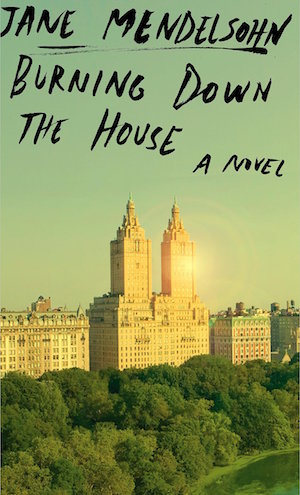Jane Mendelsohn’s Burning Down The House is an ornate glass box of beautiful spiders.
The analogy is as apt as it is unwieldy and requires some unpacking, but that’s an exercise that Mendelsohn’s readers will no doubt understand. The delicate little creatures located in the glass box—the world within the novel—are the members and satellite casualties of the Zane family, House’s fabulously wealthy and fabulously unhappy family residing in the Manhattans of American literature. They are quite capable of weaving intricate sculptures of great beauty: ephemeral architecture at once intensely powerful and inherently mutable, connecting the feelings, ideas and actions of a story with many moving pieces. It’s the kind of complex relationship best understood as, well, a web. Beautiful spiders weave these intricate relationships, but they are, of course, repulsive beasts as well.
 In tracing the fall of patriarch Steven Zane’s real estate kingdom and the sickening gyres of sex trafficking, Mendelsohn has written a novel in stereoscopic Victorian fashion that puts fear on display—fear of parents for their children, of replacement, of loss, of self, of others. House offers a luxurious look at this fear, with the Zanes’ station serving as both magnifying glass and expediter (it’s easier to worry about interpersonal conflict when one’s economic needs are met!).
In tracing the fall of patriarch Steven Zane’s real estate kingdom and the sickening gyres of sex trafficking, Mendelsohn has written a novel in stereoscopic Victorian fashion that puts fear on display—fear of parents for their children, of replacement, of loss, of self, of others. House offers a luxurious look at this fear, with the Zanes’ station serving as both magnifying glass and expediter (it’s easier to worry about interpersonal conflict when one’s economic needs are met!).
Perhaps drama in the Greek fashion, not the Victorian, is a better metaphor. While Mendelsohn’s familial and friends-of cast is large, it is not nearly diverse enough, particularly economically, for the Dickens/Thackery/Wolfe style. House is more a family’s tragedy than a city’s, and the novel’s protagonist, Neva, is a heroine in the classic sense.
The novel begins with Neva being sold into the sex trade, from the smoky mountains of her rural youth to Moscow to the endless strip-mall edges of the New York metro area from which she escapes. It is a journey which serves to unsettle the reader—too fast to mortally wound but too terrible to dissipate this deep, abiding tragedy carried through the book.
In a cast of characters wracked with issues, Neva clearly emerges as the strongest. Atop the mighty Zane throne sits Steven, a Jovian figure whose influence is as quiet and powerful as gravity and whose failings and angers are rendered noticeable but inscrutable. His wife Patrizia glides through the book like cigarette smoke—expensive cigarette smoke, but ephemeral all the same. Their children are the hyperactive, budding conqueror Roman and the painfully intelligent Felix. These children are joined by Steven’s middle-aged older children, the depressed and ghostly Alix, whose presence is similar to Patrizia’s but carries with it a sudden, icy draft, and the delightfully anomic, fearsome Jonathan, prince in waiting. Caught between these two generations is Poppy, the orphaned and adopted daughter of Steven’s sister. Ian, a musical director and Alix’s best friend since college, is the only non-Zane of importance.
Fear not for keeping these names straight. Mendelsohn is an expert juggler of characters, and even with a cast list this long, she carefully balances the Zanes and near-Zanes. The interplay between them feels natural and is perhaps the strongest technical quality of the book. Regardless of what one thinks about Mendelsohn’s purple prose, her ability to foster what feels like genuine interactions between her characters keeps the Zanes—and the novel—from becoming just another Tragedy in the Ivory Tower.
The line-by-line quality of that purple prose is the novel’s greatest strength and biggest flaw. There are flashes of stunning beauty, like when Mendelsohn describes Steven’s chest rising and falling like an empire or a dress of “threaded nothingness.” But Mendelsohn is at her best in House when things are at their worst. At times, she can come across as tautological (“She sees his fall as she sees her fall. The dropping from a great height. The gulf between high and low.”) To be fair, this is the bane of most florid writers, this reviewer included, who struggle beneath the weight of many metaphors and similes. There is, in the weakest moments, a sense of great talent with little aplomb.
When the book takes its darkest turns—the brutal abuses of those being trafficked, or the terror of a structure fire—Mendolsohn shines. It is as if the pain becomes a focusing lens and the lyrical depictions of violence—never graphic, and more powerful for it—demonstrate a remarkable composure in the face of savagery. That Mendelsohn cannot close House with its brilliant climax, but must tack on an epilogue which dilutes it, serves as a microcosm for the book as a whole.
Good and bad, the purple hues and chemical reactions propel the true narrative of House, the one Neva escapes and then finds below the surface of her new life. Neva regards herself as a river, a powerful force capable of receiving and devouring all. While it takes roughly the entire novel, Mendelsohn’s redirection of that river into the seedy hotels and salon basements from which Neva long ago pulled herself is thrilling, akin to standing on Camus’ beach with the Arab down the sights. That Burning Down the House ends in conflagration seems not only right, but inevitable.
One only wishes Mendelsohn had not built anew in the ash.
B. David Zarley is a freelance journalist, essayist and book/music/art critic currently based in Chicago. A former book critic for The Myrtle Beach Sun News, his work can be seen in Hazlitt, VICE, VICE Sports, The Creators Project, Sports on Earth, The Classical and New American Paintings, among numerous other publications. You can find him on Twitter or at his website.

 In tracing the fall of patriarch Steven Zane’s real estate kingdom and the sickening gyres of sex trafficking, Mendelsohn has written a novel in stereoscopic Victorian fashion that puts fear on display—fear of parents for their children, of replacement, of loss, of self, of others. House offers a luxurious look at this fear, with the Zanes’ station serving as both magnifying glass and expediter (it’s easier to worry about interpersonal conflict when one’s economic needs are met!).
In tracing the fall of patriarch Steven Zane’s real estate kingdom and the sickening gyres of sex trafficking, Mendelsohn has written a novel in stereoscopic Victorian fashion that puts fear on display—fear of parents for their children, of replacement, of loss, of self, of others. House offers a luxurious look at this fear, with the Zanes’ station serving as both magnifying glass and expediter (it’s easier to worry about interpersonal conflict when one’s economic needs are met!).